Have you ever seen any monkey whose head is bigger than its body? Well, if you have not, today I have one for you! You can have a look at our clever friend who is a squirrel monkey. Not just clever only but also has higher intelligence and adaptability.
Moreover, we all know that monkeys love to jump around, and their tails are prehensile which helps to grip branches. But squirrel monkeys are different as their tails are non-prehensile.
Just like the above-mentioned ones, there are numerous other facts that sets the squirrel monkeys apart from the other species. I have accumulated those for you. Check out –
How Many Types of Squirrel Monkeys Are There?
The social and human-friendly monkeys are divided into five types. In the table mentioned down below you can have a look at their names and some features.
| Squirrel monkey names | Features |
|---|---|
| 01. Common squirrel monkey | 1. Mostly seen in the Amazon rainforest and in areas around it 2. Has olive-green fur with bright yellow legs and a white patch on the face |
| 02. Black-capped squirrel monkey | 1. You can find them in Bolivia, Peru and Brazil 2. What makes them distinctive from others is the black cap on their head |
| 03. Central American squirrel monkeyx | 1. Their name says where they live, which is Central America and southern Mexico 2. The whole body has a gray shade of fur with a yellow or orange tinge on the legs and tail |
| 04. Golden-backed squirrel monkey | 1. Can be differentiated by the unique golden patch on their back |
| 05. Collins squirrel monkey | 1. Their fur color is dark brown and found in western Brazil and eastern Peru |
What Are the Physical Features of Squirrel Monkeys?
Now, introducing you to the friendliest monkey species’ physical features which are just as unique as the monkey itself. Beginning with the body shape which is smaller than its head.
Besides, do you know that squirrel monkeys’ color vision varies depending on their sex and species? Well, males are dichromatic and females trichromatic. Unfortunately, their night vision is not as good as in the daytime. But has a sharp eye to navigate dense rainforest canopy.

Other than eyes, their hearing ability can overshadow the range of human earrings. As they can hear sounds up to 20 Hz to 80 kHz.
Due to having such a wide range of hearing ability, they can perceive high-frequency sounds through insects, small birds, etc. That means they understand the differences in pitch. Yes, they can decipher accurate details of other environmental sounds.
However, while other monkeys can grab branches through their tail, squirrel monkeys are unable to do so because of not having a prehensile tail.
Apart from that, your little affectionate friend can be highly vocal. They comprise a vast repertoire of 25-30 unique calls that give the allowance to communicate with each other.
Most importantly, their bright yellow legs and visible markings in facials sets them apart from other monkeys.
You can have a look at the below table to pick some pin-point details on them.
| Features | Some facts |
|---|---|
| Scientific name | Saimiri |
| Communication | Through vocalizations, body language and facial expressions |
| Height | 1. Female: body length 9-13 inches 2. Male: body length 10-14 inches |
| Length | 1. Female: tail length 14-17 inches 2. Male: tail length 14-17 inches |
| Weight | 1. Female: 1.5-2.5 pounds 2. Male: 1.3-2.3 pounds |
| Lifespan | 1. In the wild: 15 years 2. In captivity: 20 years |
| Reproduction | Females generally give birth every other year |
| Color | Has a short coat of fur that is gray to olive |
| Habitat | Lives in the tropical rainforest of South America. Mostly found in the middle layers of forest canopy but can be seen in the ground or upper layers of forest canopy too |
| Mating | Polygamous and both are promiscuous |
| Running speed | 22 miles per hour |
| Sexual maturity | Females’ maturity comes within 2.5-3.5 years old whereas males mature at 4-5 years old |
| Gestation period | 160-170 days approximately 5.5 months |
| Breeding season | September-November |
| IUCN red list | Not threatened |
What Factors Do Squirrel Monkeys Keep in Mind While Choosing a Habitat?
Just like other animals, squirrel monkeys keep some facts in mind while choosing a habitat. I will break the facts into some sections now –
Availability of food and water
First comes the availability of a sufficient amount of food. As they have a diverse diet with fruits being their major supplier of energy. For which they look for fruiting trees which give a year-round food supply.

Then comes the availability of water supply. They intake water from rivers, and streams when required. And thus, they prefer a place where they find water availability around. This includes water from puddles and tree holes, and fruit trees that help them hydrated.
Other than consuming fruits and water, they try to choose habitats where there is a large amount of insect populations.
Thick vegetation
Moving on, after assurance of food and water they look for places that have dense foliage. They choose a thick canopy that covers and protects them from their prey Thus, interconnected trees and branches give them the chance to escape easily when there are any potential threats.
Groups
Accordingly, their habitat includes social interaction too as they live in large groups. For living connected, it enhances their social network, provides mates and gives them information about resources.
Like to know more about their living life? Read this article “Clarifying the Habitat of Squirrel Monkeys at A Glance”.
What Food Does This Squirrel Monkey Eat?
Most of the monkeys are omnivores and our squirrel monkeys are not indifferent too. They eat both plant and animal-based foods. Even their diet includes nuts, buds, leaves, etc.
For their protein and fat sources, they depend on eating insects. That gives them high energy and agile movements. And in order to access these foods, they use sticks or stones, etc.
If you are interested in learning more about the diet of squirrel monkeys, you may read my article “Explore squirrel monkey food and diet”.
How Does a Squirrel Monkey Behave?
Let’s embark on a concise description of how these highly social and active creatures behave. Here’s a glimpse into their behavioral world –
Social animal
For safety and social purposes, squirrel monkeys stay in groups. However, the number of monkeys to remain in a troop varies. It can be dozens to even hundreds of individuals too.

And their communication behavior is just like I mentioned. They have a variety of calls and expressions for passing information from one to another.
Movement and activities
Squirrel monkeys are mostly active during the daytime and sleep for 7 to 13 hours per day. Yes! Squirrel monkeys’ sleeping pattern includes a longer timeline. Age, health and other factors can increase or decrease the time period of sleep.
Additionally, just like other monkeys, squirrels are playful and love to chase, wrestle, etc. Moreover, you’ll be surprised to know that squirrels use scent marking too. It gives them the opportunity to communicate with other monkeys.
Plus, they love to sunbathe. This sunbathing helps them to regulate their body temperature and ensure Vitamin D production too. They also groom each other. For this reason, it removes their parasites and ensures a secure social bond among the troops.
Peeing habits
Squirrel peeing habit is another factor that falls under their behavioral aspects. Some common things that happen while they pee-urinate frequently and they pee on the ground, trees, or leaves because they don’t have designated toilet areas.
These creatures could be able to pull this off because they spend so much time in trees and the forest.

However, squirrel monkeys are often clean animals, despite the lack of a home for their waste. In order to eliminate any possibility of urine on themselves or one another, they clean up after themselves frequently.
Jumping habits
In the Amazon, squirrel monkeys perform nimble acrobatics. These tiny apes demonstrate both their playful side and their vital survival abilities through the variety of ways they use their jumps.
Leaping abilities
The agile build allows them great control and balance in the air thanks to their long limbs, slim bodies, and prehensile tails. Plus, their powerful rear legs allow them to cover great distances with ease.
Moreover, as their spines are quite flexible, they can twist and change their landings as they jump, which makes them very safe. To help maintain balance and control when in flight, their prehensile tail doubles as a rudder.
Styles of jumping
Their common style is brachiation. This motion entails hopping from one branch to another with the help of the forelegs and arms.
And a squirrel monkey’s bouncing abilities include a powerful horizontal jump that can reach several meters. They can also leap up to five meters in the air to get to food or avoid danger.
If you are interested in learning more about the squirrel monkeys behavior, you may read my article.
How Do Squirrel Monkeys Reproduce?
Squirrel monkeys engage in mating behavior exclusively during specific seasons. This occurs for the majority of species during the rainy season (September–November) when food is abundant.
However, when the breeding season arrives, biochemical changes are noticed in both sexes. And when a female is physically prepared to mate, she may exhibit symptoms including an increase in the size of her genitalia or a change in her scent.
At that time, men compete with one another by putting on various shows in an effort to attract females. Even a male leaves a scent mark or even chases another male to demonstrate his dominance.

After the selection procedure when the mating part arrives, the male takes a position on top of the female. But no particular “courtship” ritual is observed in them before mating.
However, after fertilization is complete, the gestation period begins and continues for around 160–170 days. One surprising fact is that twins are extremely unusual, and most pregnancies only result in the birth of one infant.
Just like many other animals, after birth, male squirrel monkeys do not provide any kind of nurturing care for their younger ones. Thus, raising a child is solely the responsibility of the mother.
What Are the Conservation and Threats for Squirrel Monkeys?
The International Union for the Conservation of Nature (IUCN) describes some squirrel monkey species as “Least Concern”. But others, such as the Central American squirrel monkey, are listed as “Endangered.”

But why they are in danger let’s see –
Due to logging, farming and other forms of deforestation, it is noticed that their rainforest homes are at stake. As they live in dense forests, it is destroying their scope of habitat formation.
Moreover, a bulk amount of squirrel monkeys is illegally traded now. Because of this tragic capture, their population is rapidly declining.
What Can We Do to Help Squirrel Monkeys?
In order to save them from extinction, measures should be taken. Such as the establishment and maintenance of protected areas, like forests and national parks, provide squirrel monkeys with vital habitat security.

Moreover, habitat restoration through tree-plantation will reconnect fragmented ecosystems and restore destroyed rainforest regions. More importantly, creating awareness of environmental issues and engaging people in conservation efforts will be great.
On top of that, stricter regulations and stricter enforcement are crucial to reinforce the battle against illegal trade and hunting.
Frequently Asked Questions
Now, let’s check out some commonly asked questions regarding squirrel monkeys.
How do squirrel monkeys adapt to their environment?
Squirrel monkeys are adaptable as they can adapt to the diet to suit what’s in season. As a result, they are better able to adapt to changing weather patterns and climates by finding other food sources. Thus, they have mastered the art of collective movement to evade predators.
What helps a squirrel monkey to survive in adverse weather conditions?
In order to stay cool, squirrel monkeys have evolved a few interesting ways to behave, and stay calm physically. Such as their thick coats that act as insulators.
Another way they stay cool is by evaporative cooling. Their faces and paws are equipped with sweat glands that keep them cool.
Why are squirrel monkeys commonly referred to as “squirrels”?
Squirrel monkeys earned their name from the way they act. The term “arboreal” describes animals that make their home in trees and spend much of their time hopping from one limb to another. The fact that they are small, swift, and nimble also explains why they were originally dubbed “squirrels.”
Does a squirrel monkey live by itself?
No. Sometimes there can be as many as a hundred squirrel monkeys in a single group, but more often there are mixed groups of fifteen to fifty.
Who are squirrel monkey enemies?
Predatory birds, snakes, and cats all hunt on squirrel monkeys in Central America. Snakes, both deadly and rat-like, prey on squirrel monkeys. Raptors have an easier time catching Central American squirrel monkeys.
Can squirrel monkeys be kept as pets?
Squirrel monkeys as pets are not something we support. This is primarily due to the fact that native squirrel monkeys inhabit tropical rainforests and wetlands. Here they spend the vast majority of their time perched on trees. As pets, it might be challenging to recreate conditions similar to their natural habitat.
Conclusion
We ae at the end of our today’s discussion. But do you know one fun fact about them? It’s quite hard to differentiate which one is male and which is female just by seeing them.
However, squirrel monkeys are social and friendly creatures whose habitats are on the danger list according to researchers. It’s high time for us to become aware and protect those species that protect our mother nature.

